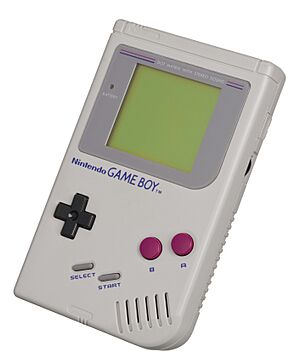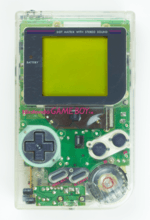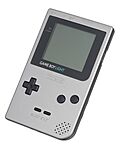Game Boy facts for kids

An original Game Boy
|
|
| Also known as |
|
|---|---|
| Developer | Nintendo R&D1 |
| Manufacturer | Nintendo |
| Product family | Game Boy |
| Type | Handheld game console |
| Generation | Fourth |
| Release date |
|
| Retail availability | 1989–2003 (14 years) |
| Introductory price | ¥12,500 (equivalent to ¥14,327 in 2019) US$89.99 (equivalent to $212.45 in 2022) GB£99 (equivalent to £162.17 in 2021) DM 169 (equivalent to DM 246.35 in 2021) |
| Discontinued | Yes |
| Units sold | Worldwide: 118.69 million (including Play It Loud! edition, Game Boy Pocket, Game Boy Light and Game Boy Color units) |
| Media | Game Boy Game Pak |
| Power | 4 × AA batteries |
| CPU | Sharp LR35902 core @ 4.19 MHz |
| Display | STN LCD 160 × 144 pixels, 47 × 43 mm (w × h) |
| Dimensions | 5.8”/148 mm × 3.5”/90 mm × 1.3”/32 mm (l × w × d) |
| Weight | 7.76 oz/0.22 kg (without batteries) |
| Best-selling game | Tetris (approximately 35 million units) |
| Predecessor | Game & Watch |
| Successor | Game Boy Color |
The Game Boy is a super popular handheld game console made by Nintendo. It was one of the first portable gaming systems you could take anywhere! It first came out in Japan in 1989, then in North America and Europe soon after.
This console was designed by the same team that made the Game & Watch handheld games. These designers were Satoru Okada, Gunpei Yokoi, and the Nintendo Research & Development 1 team.
The Game Boy was Nintendo's very first handheld console. It combined ideas from the Game & Watch and the NES home console. It had a screen with adjustable contrast, eight control buttons, and a speaker. Like other consoles, it used game cartridges. The Game Boy was mostly grey with black, blue, and dark pink accents.
When it first launched, you could buy it alone or bundled with games. Popular games like Super Mario Land and Tetris were often included. Many cool accessories were also made, like a carrying pouch, a camera, and even a printer!
Even though some people thought it looked bulky or had simple graphics, the Game Boy quickly became a huge hit. It sold a million units in the United States in just a few weeks! Over 118 million Game Boy and Game Boy Color units were sold worldwide. This makes it one of the best-selling video game consoles ever. It became a cultural icon of the 1990s. Nintendo kept making Game Boy consoles until 2003.
Contents
How the Game Boy Was Made
The Game Boy was designed by Nintendo's main engineer, Gunpei Yokoi, and his team. After the NES became popular, Yokoi wanted to create a handheld system. This new system would let players change games, unlike the older Game & Watch.
The Game Boy's first secret name was Dot Matrix Game. This name came from its screen, which used tiny dots to make pictures. The Game & Watch, made earlier by Yokoi, had simpler screens. The letters "DMG" are still on the Game Boy's model number: "DMG-01".
Yokoi and Satoru Okada led the Game Boy's creation. Yokoi believed the console should be small, light, and strong. He also wanted it to have many fun games. A writer named Shigesato Itoi came up with the name "Game Boy." At first, some people at Nintendo didn't like the idea. They even called it "DameGame," which means "hopeless game."
Okada wanted the Game Boy to be a portable version of the NES. He also wanted to make it easier for other companies to create games for it. They first thought about using a powerful computer chip like the NES. But because Nintendo was also making the Super NES, they chose a less powerful chip.
Screen Technology and Design Choices
Making the Game Boy's screen was a big challenge. Nintendo talked to a company called Sharp about making the screen. Sharp was not sure if they could make the right kind of screen. Nintendo then looked at another company, Citizen, for a screen.
But Sharp didn't want to lose the deal with Nintendo. So, they came back with a better offer. Okada kept asking Sharp questions and showing them a Game Boy prototype. This helped Sharp decide to work with Nintendo.
The first screen type they picked had a narrow viewing angle. This meant you had to look at it straight on. Nintendo's president, Hiroshi Yamauchi, didn't like this. So, they switched to a different screen technology called STN. This screen was more expensive but had better viewing angles. To keep costs down, they made the screen a bit smaller.
Gunpei Yokoi believed in using older, proven technology. This idea was called "Lateral Thinking with Withered Technology." It meant using reliable, cheaper parts in new and smart ways. To save money and battery life, the Game Boy did not have a backlight. It also used a simple grayscale screen instead of color.
The Game Boy also had cool features for players. It came with headphones for private, stereo sound. You could buy an extra battery pack for longer playtime. A link cable let two players connect their Game Boys for multiplayer games. The console was also built to be tough.
Okada thought of the link cable idea because he had worked on a game that used cables. Many people at Nintendo thought this feature would not be used. But Okada pushed for it and even wrote some of the code himself. This led to the "battle" and "trade" features in the famous Pokémon games.
Game Boy's Big Debut
Nintendo showed off the Game Boy in 1987. It had a special control pad called the "D-pad." Gunpei Yokoi designed this flat controller. He knew that regular joysticks would make handheld devices too big.
Nintendo's president thought the Game Boy would sell over 25 million units in three years. This was a very bold prediction back then!
Nintendo believed that great games made a system popular. So, Gunpei Yokoi and Satoru Okada made Super Mario Land. It was a portable version of Super Mario Bros. and was meant to be the Game Boy's main game.
However, Henk Rogers showed Nintendo of America a game from the Soviet Union called Tetris. Even though Tetris had simple graphics, it was perfect for a handheld device. Nintendo's president, Minoru Arakawa, decided to include Tetris with the Game Boy.
So, Tetris was bundled with the Game Boy in most places outside Japan. The Game Boy was released in Japan in April 1989. It came out in North America in July and in Europe in September of the next year. Nintendo spent $10 million on marketing the Game Boy. The last Game Boy units were sold by March 23, 2003.
Game Boy Hardware Details
The Game Boy has four main buttons: "A", "B", "SELECT", and "START". It also has a directional pad for movement. On the right side, there's a dial to control the volume. On the left, there's a dial to change the screen's contrast.
At the top, you'll find the power switch and the slot for game cartridges. The power switch has a special lock. This stops you from taking out or putting in a game cartridge while the Game Boy is on. Nintendo suggested keeping a cartridge in the slot to keep dust out.
The Game Boy also has ports for other things. On the left side, there's a jack for a power adapter or a rechargeable battery pack. This lets you play without using AA batteries. The Game Boy needs 6 V of power.
At the bottom, there's a headphone jack. You can plug in headphones or external speakers to hear the game's sound in stereo.
On the right side, there's a port for a link cable. This cable lets you connect two Game Boys together. You can play multiplayer games with a friend, like Tetris. This port can also connect to a Game Boy Printer. The link cable was later used by game designer Satoshi Tajiri for trading and battling in the Pokémon games.
Play It Loud! Edition
On March 20, 1995, Nintendo released special Game Boy models with colored cases. They called this the "Play It Loud!" campaign. In Japan, it was known as Game Boy Bros. .
These special Game Boys came in red, yellow, green, blue, black, white, and clear (transparent). The clear one was sometimes called "x-ray." The screens on these "Play It Loud!" models also had a darker border than the original Game Boy.
Game Boy's Specs
| Size | About 90 mm (3.5 in) x 148 mm (5.8 in) x 32 mm (1.3 in) (Width x Height x Depth) |
|---|---|
| Weight | About 220 g (7.8 oz) |
| Screen | 2.6 inch reflective STN liquid-crystal display (LCD) |
| Screen Size | Original: 47 mm (1.9 in) by 43 mm (1.7 in) Pocket: 48 mm (1.9 in) by 44 mm (1.7 in) |
| Screen Refresh Rate | 59.7 frames per second |
| Power | 6 V, 0.7 W (uses 4 AA batteries) |
| Battery life | About 15 hours of gameplay |
| CPU | Custom 8-bit Sharp LR35902 chip at 4.19 MHz |
| Memory | 64 KB of memory, including:
|
| Screen Resolution | 160 (width) × 144 (height) pixels |
| Color support | 2-bit (four shades of "gray," from light to very dark olive green)
|
| Sound | 4 sound channels (2 pulse waves, 1 wave sample, 1 noise)
The Game Boy has one speaker, but headphones give stereo sound. |
| Input |
|
Game Boy Revisions
Nintendo released updated versions of the Game Boy.
- Game Boy Pocket: This version came out in 1996. It was smaller and lighter than the original Game Boy. It used two AAA batteries and could play for about 10 hours. The Game Boy Pocket had a clearer black-and-white screen, which was a big improvement. It also made "ghosting" (blurry trails from moving objects) much less noticeable. The first Game Boy Pocket didn't have a power light, but Nintendo quickly added one. Many different colors were released, and some were special limited editions.
- Game Boy Light: This version was released in 1998, but only in Japan. The Game Boy Light was a bit bigger than the Pocket. Its best feature was a backlight! This meant you could play in the dark. It used two AA batteries and could play for about 12 hours with the light on. It came in gold and silver, plus many special editions.
Popular Game Boy Games
The Game Boy launched with six games. Here are some of the first games you could play:
| Name | JP | NA | EU | Notes |
|---|---|---|---|---|
| Alleyway | A game like Breakout | |||
| Baseball | A sports game | |||
| Super Mario Land | A platform game from the Super Mario series | |||
| Tennis | A sports game | |||
| Tetris | A puzzle game that became super famous | |||
| Yakuman | A Mahjong game |
Re-releases of Games
Many Game Boy and Game Boy Color games have been re-released on newer Nintendo consoles. For example, on June 6, 2011, Nintendo started the Virtual Console service on the Nintendo 3DS. You could download and play classic Game Boy games there. Most of these re-releases did not support multiplayer.
More recently, on February 8, 2023, Nintendo added Game Boy and Game Boy Color games to its Nintendo Switch Online service. This lets a new generation of players enjoy these classic titles!
See also
 In Spanish: Game Boy para niños
In Spanish: Game Boy para niños





